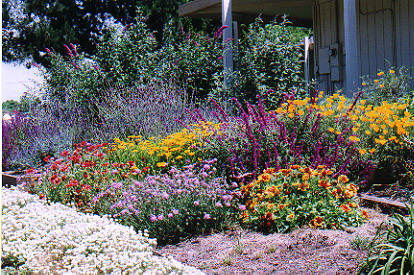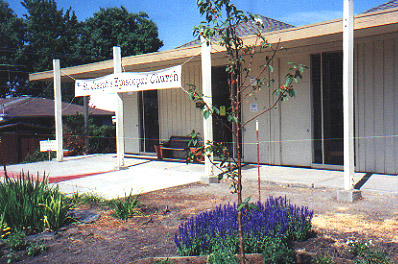
Changes Are A-Comin' (If Only the Rain Will Stop!) - March 2000
 The wet, chilly spring is taking its toll on the heat lovers-and not just us people types! The much-dreaded root rot is making a late winter appearance, and many of the cool-weather annuals have decided we're having entirely too much of a good thing!
The wet, chilly spring is taking its toll on the heat lovers-and not just us people types! The much-dreaded root rot is making a late winter appearance, and many of the cool-weather annuals have decided we're having entirely too much of a good thing!
As the rains taper off and the soil begins to warm up, look for the spring flowers to start making up for lost time. The snapdragons and pot marigolds (calendula) are setting buds, and the butterfly bushes and Mexican bush sage are starting to leaf out in earnest.
In the meantime, heartier types just laugh at the gray days and cold downpours. Check out the smiles (and the cheerful blooms) on the rosemary, miniature daisies (chrysanthemum paludosum) and spring star flowers (under the crabapple tree). Their happy white-and-yellow and light blue blooms really brighten up these dark chilly days!
This is a stressful time for birds and other small wildlife. The ample seedheads and ripe vegetation of fall have been eaten, trampled, or soaked, and the spring growth isn't really under way yet. The bird feeders are more popular than ever, and crowds of chattering songbirds feast on the banquet even in pouring rain.
No matter how wet it is, one or two little songsters can be found enjoying a refreshing dip in the water dish. So what if the sun is hiding and rain is falling-they dip and splash with happy abandon,
 ruffling up their feathers and shaking off the excess seemingly without a care in the world.
ruffling up their feathers and shaking off the excess seemingly without a care in the world.
Recently, while cleaning up the bog garden (Japanese iris, Siberian iris, and the blue and yellow flag iris are all pushing up new growth in eager anticipation of warm sunny days to come), I enjoyed the antics of a flock of little white-crowned sparrows (look for the two bright white stripes right on top of the head--Clorox would be proud to get your clothes so clean!). These shy little songsters search for seeds and insects in leaf litter and under bushes. At times there were so many running hither and yon that the garden floor itself seemed to be in motion!
Spring Plans: One of our local Boy Scouts is bringing a proposal to the Board of Trustees to build the second retaining wall between Jones Hall and the upper building as part of his Eagle Scout project. If all goes well, we'll be ready to plant both new beds by late April. And, with just a little bit of luck, fragrant roses and billowing clouds of baby's breath will soon liven up the west side of the entrance to Jones Hall.
Meanwhile, we're setting more path edgings, pulling an awful lot of weeds, and hoping the thyme survives the wet clay. If you'd like to help out, see Cliveden or Guy Haas--we can always use a few more hands in the fields!
The Garden in Winter - January 2000
As the early morning mist begins to lift, a crowd of
house finches sweeps down on the sunflower seed feeder,
chattering and jostling for position. A couple of white-crowned
sparrows have come along for the fun and are busily gleaning
the choice morsels dropped by their noisier neighbors.
 The little crabapple tree hosts a jaunty mockingbird,
cheerfully stripping the last of the tiny bright orange
fruit. How pleased she and her family will be next year,
when the Peace Tree sets its first crop as well!
The little crabapple tree hosts a jaunty mockingbird,
cheerfully stripping the last of the tiny bright orange
fruit. How pleased she and her family will be next year,
when the Peace Tree sets its first crop as well!
The larger bushes have been trimmed back to give room and light to the spring bulbs. The earliest are already pushing their grass-like stalks up through the leaf litter, and a few pale blue buds are opening. The red thyme (which is a deep rose pink) has a few scattered blooms, and the lavenders and lantanas keep on bravely blooming as the sages and basil begin to fade. Newly-planted cool-weather annuals—snapdragons, calendula, and chrysanthemum paludosum (miniature daisies)—are sending down their roots and settling in for the winter. The nasturtiums are in their element (cool days and plenty of moisture) and seem intent on taking over as much space as they can grab.
Look for: hummingbirds and several species of bee visiting the Graham's sage (cheerful red flowers on a low bush near the Peace Pole), goldfinches harvesting the blackened coneflower seedheads, a shy junco or two hunting seeds amongst the lavender, and a very bossy jay telling everyone just how it should all be done. Sunny afternoons bring out the butterflies and bees overwintering in the evergreens and scrap piles. And, of course, the bunnies come out to play (along with a few hunting cats) in the early evening. Bring a warm coat and settle down on one of the benches for a bit—you'll be amazed at the wildlife we're nurturing in the midst of suburbia!
Butterfly Garden - August 1999
Spend a little time in the Butterfly Garden and you'll
be amazed at the beauties of God's creation. On a warm sunny
afternoon butterflies flit from flower to flower (look for
monarchs, cabbage whites, skippers, blues, painted ladies,
 and a buckeye or two). At least a dozen different species
of bees work from blossom to blossom (there are tiny little
ones, huge black ones, ordinary honeybees, silvery workers,
splashy bumblebees, and a whole lot more). Bushtits and
house finches search for seeds in the butterfly bushes
(Buddleia davidii). Hummingbirds visit the various
sages. Doves and sparrows check out the action among the
zinnias. A flashy mockingbird has her eye on the strawberries
for a quick snack. Brown and gray lizards and a couple of
bright orange-and-black skinks lurk in the underbrush.
The occasional rabbit wanders by for a snack and a friendly
black-and-white cat checks out the hunting opportunities.
Ladybugs explore for aphids, ants hurry along their highways,
dragonflys meander by, and all sorts of weird little insects
climb and buzz and generally tend to their business.
Don't forget to search among the nasturtiums and milkweed
for caterpillars munching away.
and a buckeye or two). At least a dozen different species
of bees work from blossom to blossom (there are tiny little
ones, huge black ones, ordinary honeybees, silvery workers,
splashy bumblebees, and a whole lot more). Bushtits and
house finches search for seeds in the butterfly bushes
(Buddleia davidii). Hummingbirds visit the various
sages. Doves and sparrows check out the action among the
zinnias. A flashy mockingbird has her eye on the strawberries
for a quick snack. Brown and gray lizards and a couple of
bright orange-and-black skinks lurk in the underbrush.
The occasional rabbit wanders by for a snack and a friendly
black-and-white cat checks out the hunting opportunities.
Ladybugs explore for aphids, ants hurry along their highways,
dragonflys meander by, and all sorts of weird little insects
climb and buzz and generally tend to their business.
Don't forget to search among the nasturtiums and milkweed
for caterpillars munching away.
After two and a half years of digging, planting, pruning, and tending, the plants have taken hold and most of the landscaping is in place. There are still edgings to finish and the watering system isn't quite balanced yet, but the fences are finally coming down. Take a little time to stop by and enjoy the sights and sounds of nature in our own back yard.